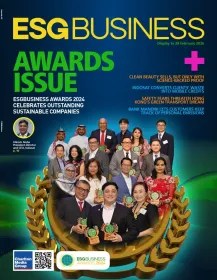
Kearney’s Tanima Singh champions ESG strategies across companies, believes collaboration is key to collective progress
She highlights how Asia-Pacific businesses are uniquely positioned to lead in green tech and resource-efficient growth.
ESG is rapidly becoming a key part of how businesses operate and succeed. As companies focus more on sustainability, the need for practical integration, measurable outcomes, and credible leadership continues to grow fast.
Tanima Singh, Specialist Principal, India at Kearney and a global ESG expert, shared her valuable insights. With over 11 years of experience across Asia, Europe, and America, she brings a deep understanding of ESG transformation strategies, decarbonisation agendas, sustainable supply chains, socio-environmental impact measurement and sustainability advisory services.
She has advised a diverse range of clients, including multinational corporations, Development Finance Institutions, and government bodies, bringing deep cross-sectoral expertise across industries such as chemicals, automotive, FMCG, textile, transport, and healthcare.
As a judge at the ESGBusiness Awards 2025, Tanima discussed the evolving ESG landscape, highlighting key shifts, persistent challenges, innovative solutions, and opportunities for leadership in the Asia-Pacific region.
Given your extensive experience across ESG transformation strategy, what major shifts have you observed in how organisations integrate ESG into their core business models over the past years?
In the last 11 years that I’ve been in the ESG world, a lot has changed. One of the most significant shifts has been the transition from reactive, compliance-driven approaches to proactive, purpose-led strategies. ESG is no longer seen merely as a risk mitigation tool but as a driver of long-term value creation and innovation. At the same time, the regulatory landscape for ESG action has also evolved significantly, with different parts of the world standing at different levels of maturity.
Companies have increasingly embedded ESG into corporate governance, linking executive compensation to ESG performance and incorporating sustainability into board-level oversight. There's also been a marked increase in transparent reporting and data-driven decision-making, enabled by advances in ESG analytics and frameworks like TCFD, SASB, and the EU Taxonomy.
Additionally, investor pressure and stakeholder activism have played a pivotal role in accelerating change, pushing organisations to set measurable goals on climate action, diversity, equity, and ethical supply chains. In many sectors, ESG is now closely aligned with brand reputation, talent attraction, and access to capital. In essence, ESG has moved from the margins to the mainstream, becoming integral to how companies define success and resilience in a rapidly changing world.
Across diverse sectors, which ESG-related challenges appear most persistent, and how can companies better address them in their operational strategies?
Across sectors, climate change and decarbonisation stand out as the most persistent and urgent ESG challenges. Whilst many organisations have committed to net-zero goals, translating ambition into action remains complex, especially for industries with hard-to-abate emissions. Challenges include insufficient access to clean technologies, regulatory uncertainty, and the need to align decarbonisation with core business growth.
Human rights represent another persistent challenge, particularly in global supply chains where visibility and accountability are limited. Issues such as forced labour, fair wages, and worker safety continue to pose reputational and operational risks. Companies can make progress by strengthening due diligence mechanisms, engaging suppliers in capacity building, and ensuring transparency through third-party audits and stakeholder engagement.
Lastly, biodiversity preservation is gaining prominence but remains under-addressed due to the difficulty of measuring impact and the lack of sector-specific guidance. However, biodiversity loss has direct consequences for ecosystem resilience and long-term business viability. Companies can act by assessing nature-related risks, integrating natural capital into decision-making, and supporting landscape-level conservation initiatives.
With your experience advising both public and private firms, what are the most effective models of public-private collaboration you've seen in driving ESG outcomes?
Some of the most impactful ESG progress in recent years has stemmed from strategic public-private collaborations that combine the policy reach of governments with the innovation and scalability of the private sector. Effective models tend to share three characteristics: shared goals, clearly defined accountability, and cross-sector stakeholder engagement.
One example of such collaboration models is a direct public-private partnership. In this model, government bodies and private companies can work together to accelerate green solutions, clean technology R&D, set emissions reduction targets, and align financing mechanisms. There have been some successful examples seen in the APAC region of this model, especially in scaling renewable energy, energy efficiency, and carbon capture programmes.
Another example is setting better industry-wide ESG standards. This model brings together regulators, brands, and civil society to improve labour conditions in global supply chains. These partnerships succeed because they emphasise transparency, continuous learning, and shared responsibility. Examples include Ethical Trading Initiative (ETI), FairTrade, Better Cotton Initiative, amongst others.
Lastly, community-centred collaborations. This includes businesses, local governments, and communities coming together to co-design solutions to environmental and social issues, ranging from green infrastructure to inclusive workforce reskilling. These models are effective in ensuring that ESG action translates into real impact at the community level, for example, the Model Village concept in India.
How can companies effectively leverage current ESG-related innovations to enhance their sustainability performance and create a measurable impact?
There are plenty of ESG innovations that companies can leverage the latest ESG-related innovations, and the extent to which they can be leveraged depends on the nature of the business and the sector that the company belongs to. Largely, it can be summed up under four broad themes.
First, the use of digital platforms & AI-driven assessment. Innovations in ESG data platforms, AI-driven risk assessment, and real-time sustainability analytics enable companies to track performance more accurately, identify hotspots, and make informed decisions. Tools like ESG dashboards, supply chain traceability software, and scenario modelling (e.g., TCFD-aligned climate risk tools) are helping organisations operationalise ESG goals and monitor progress against KPIs, especially the complex ones like Scope 3 and human rights in the supply chain.
Second, green materials and circular business models. Companies are rethinking products and services through a sustainability lens—developing circular economy models, low-carbon alternatives, and inclusive offerings. Innovations in materials (e.g., bioplastics, low-emission cement), renewable energy integration, and regenerative agriculture are examples where ESG drives both impact and competitive advantage.
Third is Sustainable Finance and Green Instruments. The rise of green bonds, sustainability-linked loans, and impact investing allows companies to access capital whilst aligning financial performance with ESG targets. By tying financing terms to measurable outcomes—such as carbon reduction or workforce diversity—companies can embed ESG into their financial architecture.
Fourth, collaboration for greater R&D. Partnering through ESG innovation labs, industry consortia, and public-private initiatives enables companies to scale solutions faster. Shared platforms for carbon accounting, biodiversity impact assessment, or social inclusion metrics help standardise practices and accelerate progress across value chains.
Looking ahead, what opportunities do you foresee for companies to take a leadership role in ESG within the Asia-Pacific region, and how can they position themselves to drive meaningful and scalable impact?
A large part of the global manufacturing and services sector is located in the Asia-Pacific region, and hence, the businesses in this region hold a unique positioning to drive meaningful impact. The companies in Asia Pacific can play a substantial role in pioneering green and clean technologies, bringing about greater production efficiency to optimise natural resource consumption, drive circular business models or products, and make a global sustainable transition feasible. Companies can drive impact by investing in renewables, energy efficiency, green manufacturing, and carbon capture technologies, whilst supporting the region’s shift toward sustainable infrastructure and mobility.
Given that a large part of the global workforce is also located in the APAC region, companies can also lead by promoting ethical and transparent supply chains. Leadership here means going beyond compliance—embedding human rights due diligence, labour protections, and inclusive procurement into core operations, and influencing suppliers and peers through capacity-building and responsible sourcing practices. With rich biodiversity and ecosystems under increasing threat, especially in Southeast Asia and the Pacific, companies in sectors like agriculture, forestry, and mining can lead in climate-positive strategies by integrating natural capital accounting, protecting high-value ecosystems, and participating in restoration projects.
However, this requires companies in the APAC region to really embed ESG into their business strategy and also engage with public sector institutions to drive large-scale impact.
In your role as a judge at the ESGBusiness Awards 2025, what key criteria will you be using to assess the nominees’ sustainable efforts?
The following criteria, in my view, are essential when evaluating a business idea with an ESG impact:
Transformation Potential: Does the initiative lead to fundamental change in how a system, sector, or business operates? For example, shifts from linear to circular models, or the level of disruption in business-as-usual, unsustainable practices.
ESG Impact: How does the initiative contribute to measurable Environmental, Social, and Governance outcomes? For example, reduction in carbon emissions, water usage, waste, Improvements in labour practices, human rights, community development, or Enhanced transparency, ethical governance, and stakeholder inclusion.
Technical Feasibility: Is the initiative technically viable with current or near-future technologies? This includes checking for proven pilot/test case results, availability of necessary infrastructure, resources, or expertise, and mitigation plans for foreseeable operational risks.
Future Scalability: Can the initiative be expanded or replicated across geographies, sectors, or supply chains? This further depends on modularity or adaptability of the solution, its business case and cost-efficiency at scale, and also the conuciveness of the regulatory environment.
Relevance to the UN Sustainable Development Goals (SDGs) and other national or global climate goals: Does the initiative align with one or more of the 17 SDGs, particularly those most material to the company or sector? How well does the initiative support climate targets such as the Paris Agreement or national climate policies (e.g. NDCs, net-zero commitments)?















